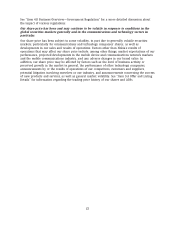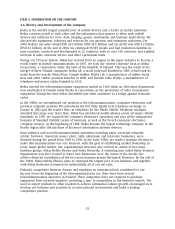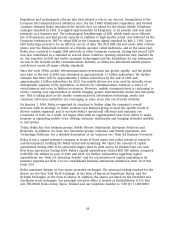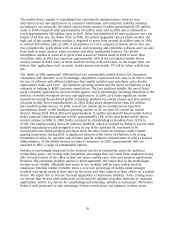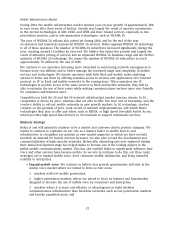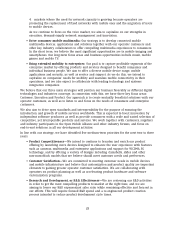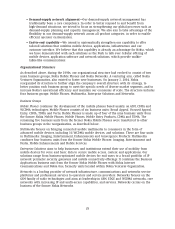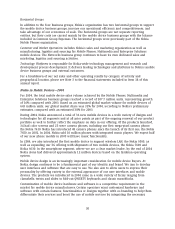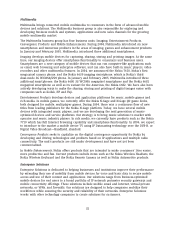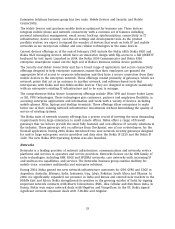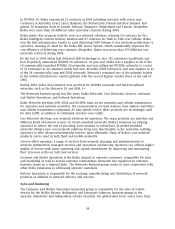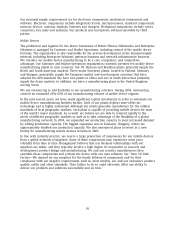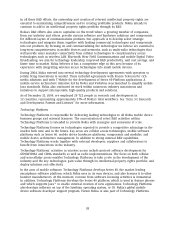Nokia 2004 Annual Report Download - page 31
Download and view the complete annual report
Please find page 31 of the 2004 Nokia annual report below. You can navigate through the pages in the report by either clicking on the pages listed below, or by using the keyword search tool below to find specific information within the annual report.Horizontal Groups
In addition to the four business groups, Nokia’s organization has two horizontal groups to support
the mobile device business groups, increase our operational efficiency and competitiveness, and
take advantage of our economies of scale. The horizontal groups are not separate reporting
entities, but their costs are carried mainly by the mobile device business groups with the balance
included in Common Group Expenses. The horizontal groups were previously part of the Nokia
Mobile Phones organization.
Customer and Market Operations includes Nokia’s sales and marketing organization as well as
manufacturing, logistics and sourcing for Mobile Phones, Multimedia and Enterprise Solutions
mobile devices. The Networks business group continues to have its own dedicated sales and
marketing, logistics and sourcing activities.
Technology Platforms is responsible for Nokia-wide technology management and research and
development process development. It delivers leading technologies and platforms to Nokia’s mobile
device business groups and external customers.
For a breakdown of our net sales and other operating results by category of activity and
geographical location, please see Note 3 to the financial statements included in Item 18 of this
annual report.
Nokia in Mobile Devices—2004
For 2004, the total mobile device sales volume achieved by the Mobile Phones, Multimedia and
Enterprise Solutions business groups reached a record of 207.7 million units, representing growth
of 16% compared with 2003. Based on an estimated global market volume for mobile devices of
643 million units, our global market share was 32% for 2004, according to Nokia’s preliminary
estimates, compared with an estimated 38% for 2003.
During 2004, Nokia announced a total of 36 new mobile devices in a wide variety of designs and
technologies for all segments and at all price points as part of the ongoing renewal of our product
portfolio as well to further reflect the emphasis on data in our offering. Of the products launched,
34 had color screens and 23 were camera phones, including our first mega-pixel camera phone,
the Nokia 7610. Nokia has introduced 48 camera phones since the launch of its first one, the Nokia
7650, in 2002. In 2004, Nokia sold 10 million phones with integrated music players. We expect half
of our new phone models in 2005 will have music functionality.
In 2004, we also introduced the first mobile device to support wireless LAN, the Nokia 9500, as
well as expanding our 3G offering with shipments of two mobile devices, the Nokia 7600 and
Nokia 6630. In the smartphone segment, where we are a clear market leader, by the end of 2004
Nokia alone had delivered approximately 12 million devices based on the Symbian operating
system.
Mobile device design is an increasingly important consideration for mobile device buyers. At
Nokia, design continues to be a fundamental part of our identity and brand. We aim to develop
user interfaces and software that are easy to use. We also aim to allow users to express their
personality by offering variety in the external appearance of our user interfaces and mobile
devices. The products we introduced in 2004 came in a wide variety of forms ranging from
clamshells, twists and slides to fold-out QWERTY keyboards and classic monoblocks.
Customization of mobile device hardware and software is a competitive requirement in the
market for mobile device manufacturers. Certain operators want customized hardware and
software with certain features, functionalities or designs together with co-branding to help them
differentiate their services and boost the use of mobile services by integrating the necessary
30




